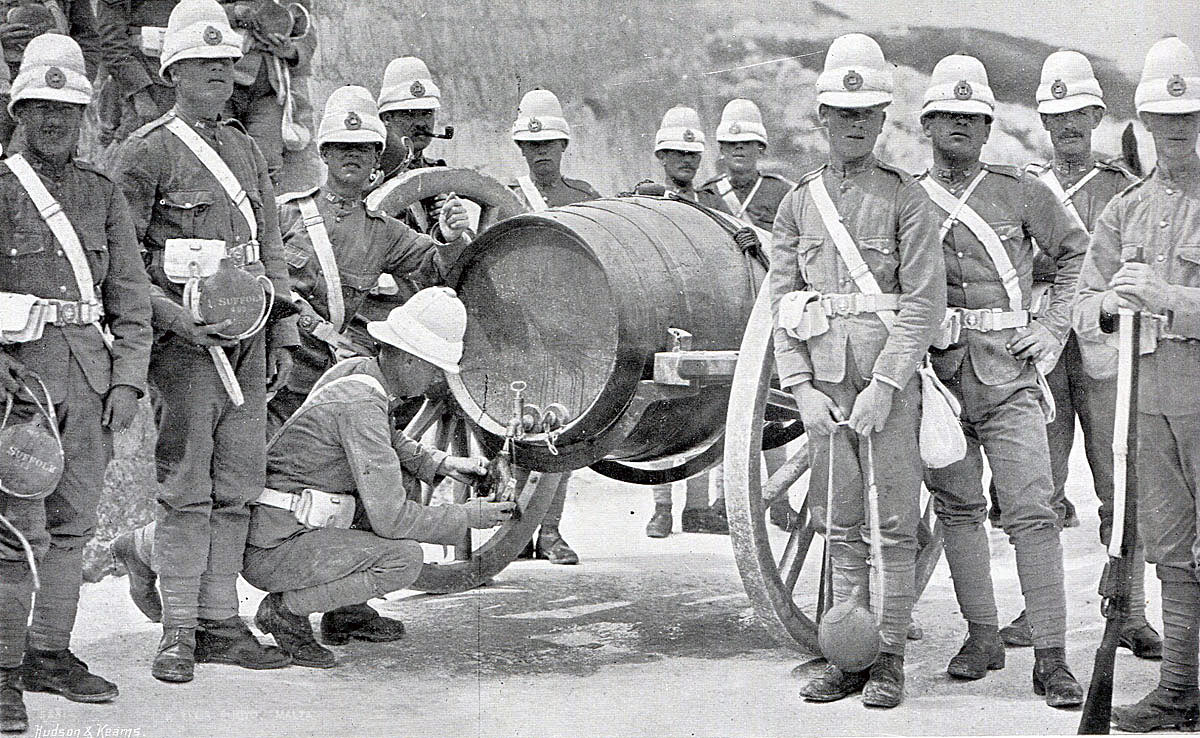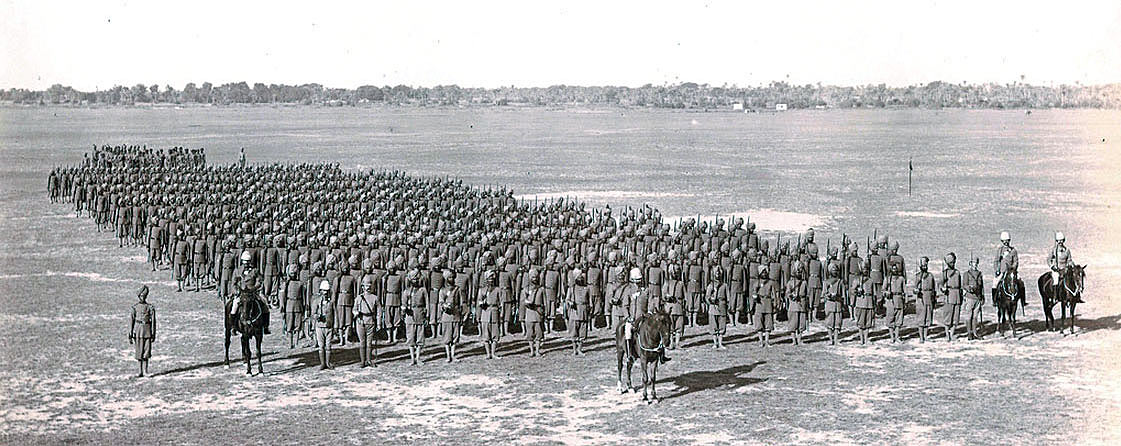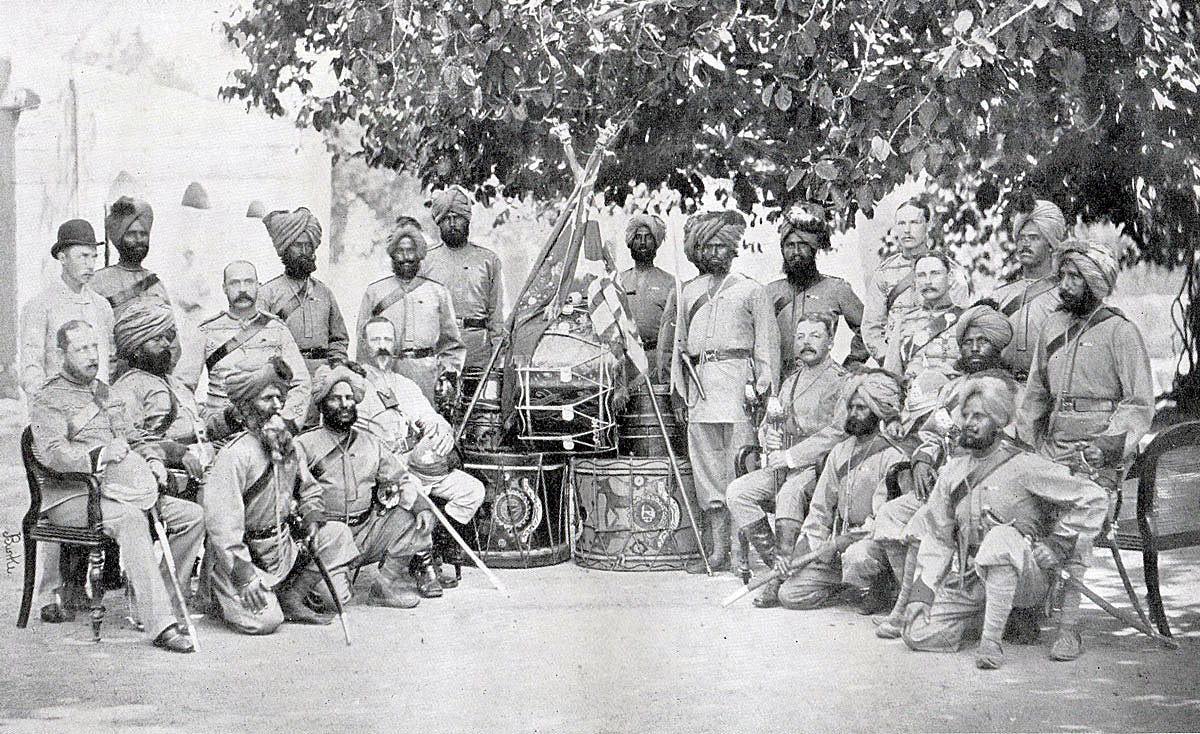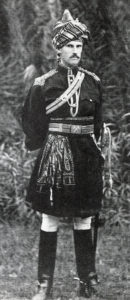The Black Mountain Expedition of October to November 1888, also known as the ‘Hazara Field Force 1888’; one of the first major campaigns on the North-West Frontier of India in the last two decades of the 19th Century
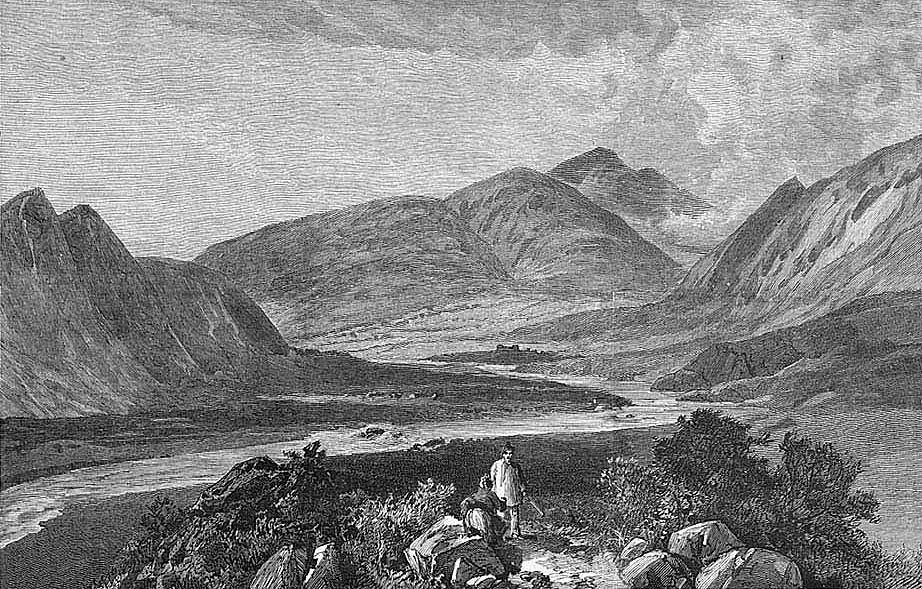
Hazara Valley and the Indus River with the Black Mountain in the distance: Black Mountain Expedition from 1st October 1888 to 13th November 1888 on the North-West Frontier of India
The previous battle in the British Battles sequence is the Siege of Ladysmith
The next battle in the North-West Frontier of India sequence is the Black Mountain Expedition 1891
To the North-West Frontier of India index
War: Operations on the North-West Frontier of India.
Date of the Black Mountain Expedition 1888: 1st October 1888 to 13th November 1888.
Place of the Black Mountain Expedition 1888: The area of the Black Mountain on the east or left bank of the Indus River to the north of the Kabul River/ Vale of Peshawar.
Combatants in the Black Mountain Expedition 1888:
British and Indian Army troops with local levies against the Pathan tribes of Hassanzais and Akazais.
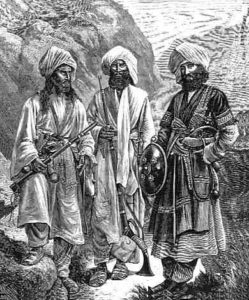
Tribesmen: Black Mountain Expedition from 1st October 1888 to 13th November 1888 on the North-West Frontier of India
The Pathans:
In 1888, the north-western border of British India was the boundary of the old Sikh state of the Punjab. This followed the Indus River to a point short of the Black Mountain.
The tribes involved in this campaign lived in the area of the Black Mountain on the east or left bank of the northern section of the Indus River beyond the border.
The Pathan tribes of Hassanzais and the Akazais (both sub-clans of the Yusufzai, being descended from sons of Yusuf, said to be the ancestor of the tribal group). The Hassanzais lived on both sides of the Indus River and comprised ten sub clans with a fighting strength of around 2,000 men.
The Akazais occupied the section of the Black Mountain to the north of the Hassanzais. The Akazais had four sub-clans and could put around 1,500 fighting men into the field.
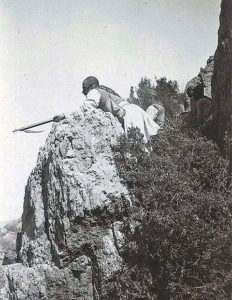
Tribesman with Enfield Rifled Musket: Black Mountain Expedition from 1st October 1888 to 13th November 1888 on the North-West Frontier of India
The Pariari Sayids, Tikaris, Nandihars and Allais: These tribes lived further to the north-east. Their country was bounded by the Indus River where it bent to the east. They were Swati rather than Pathan and had been displaced eastwards by the incursion of Pathans from Afghanistan. The British officials of the time considered these tribes to have many of the characteristics of the Pathans, but without their bravery. They seem to have fought in much the same way as the Pathans, but with less determination. Their villages in the main were unfortified.
A group described as Hindustanis based on the west bank of the Indus opposite Kanar: The Hindustanis were Muslim descendants of refugees from Central India, displaced by the Indian Mutiny of 1857, virulently anti-British and described by officials as fanatics. The Hazara expedition was not directed against the Hindustanis, but they took part in resisting the advance of the British Fourth Column up the Indus River.
The main weapons of the tribesmen were long jezails or muskets, swords, shields and knives. A force of tribal fighting men would receive directions from maliks or headmen or religious leaders, but no Pathan felt compelled to do what he was told. Movement around the battlefield was guided by common enterprise and fighting experience, rather than command.
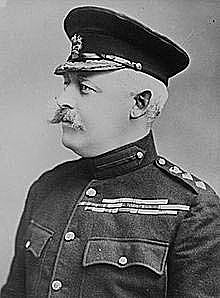
Brigadier General J.W. McQueen, Force Commander in the Black Mountain Expedition from 1st October 1888 to 13th November 1888 on the North-West Frontier of India
Pathans were agile, swift and experienced mountain fighters. The Pathan code readily gave rise to blood feuds between individuals, villages or tribes. In the face of an external enemy, the Pathans would put their feuds to one side while the invader was resisted. Many of the tribes raided across the border into British territory. There were close links between the inhabitants of the Agror Valley, who lived under British rule and their kin living across the border, which increased the tribal resentment at the existence of the border, an alien and incomprehensible concept.
The pattern of North-West Frontier incursions by the British led to the improvement of communications, through the building of tracks or roads and bridges and to the establishing of garrisons in key places.
Commanders in the Black Mountain Expedition 1888: Brigadier-General J.W. McQueen CB, ADC, acting Major-General, commanded the Hazara Field Force. There does not appear to have been any central tribal leadership.
Size of the armies in the Black Mountain Expedition 1888: 9,416 British and Indian troops against probably around 10,000 tribesmen.
Uniforms, arms and equipment in the Black Mountain Expedition 1888:
The British military forces in India fell into these categories:
- Regiments of the British Army in garrison in India. Following the Indian Mutiny of 1857, India became a Crown Colony. The ratio of British to Indian troops was increased from 1:10 to 1:3 by stationing more British regiments in India. Brigade formations were a mixture of British and Indian regiments. The artillery was put under the control of the Royal Artillery, other than some Indian Army mountain gun batteries.
- The Indian Army comprised the three armies of the Presidencies of Bombay, Madras and Bengal. The Bengal Army, the largest, supplied many of the units for service on the North-West Frontier. The senior regimental officers were British. Soldiers were recruited from across the Indian sub-continent, with regiments recruiting nationalities, such as Sikhs, Punjabi Muslims, Pathans and Gurkhas. The Indian Mutiny caused the British authorities to view the populations of the East and South of India as unreliable for military service.
- The Punjab Frontier Force: Known as ‘Piffers’, these were regiments formed specifically for service on the North-West Frontier and were controlled by the Punjab State Government.
- Imperial Service Troops of the various Indian states, nominally independent but under the protection and de facto control of the Government of India. The most important of these states for operations on the North-West Frontier was Kashmir.
A British infantry battalion comprised ten companies, with around 700 men and some 30 officers. A battalion had a maxim machine gun detachment of two guns and some 20 men.
Indian infantry battalions had much the same establishment, but without the maxim gun detachment. Senior officers were British, holding the Queen’s Commissions. Junior officers were Indian.
In this Black Mountain expedition, the regiments were directed to mobilise with 600 all ranks.
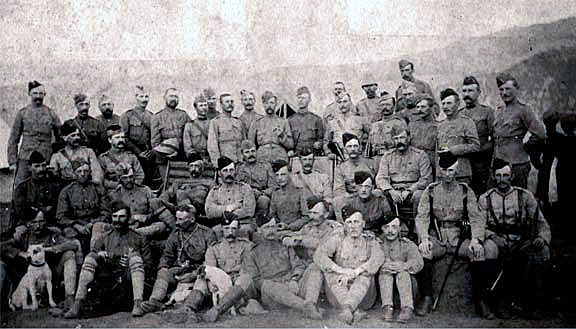
Officers of the 2nd Northumberland Fusiliers: Black Mountain Expedition from 1st October 1888 to 13th November 1888 on the North-West Frontier of India
British regiments were issued with the single shot, drop-action Martini-Henry breech loading rifle. This rifle was issued to the Indian regiments in 1888, so that a number of the regiments in the Hazara Field Force had the Martini-Henry. The remaining Indian regiments were still using the Snyder rifle, a clumsy adaptation to a breech loader of the muzzle loading Enfield rifle. Both rifles took a bayonet.
The Indian Mountain Batteries used the 7 pounder RML (rifled muzzle loader) gun that was dismantled and carried on mules. The Royal Artillery mountain batteries used the more modern 2.5-inch RML muzzle loading rifled gun.
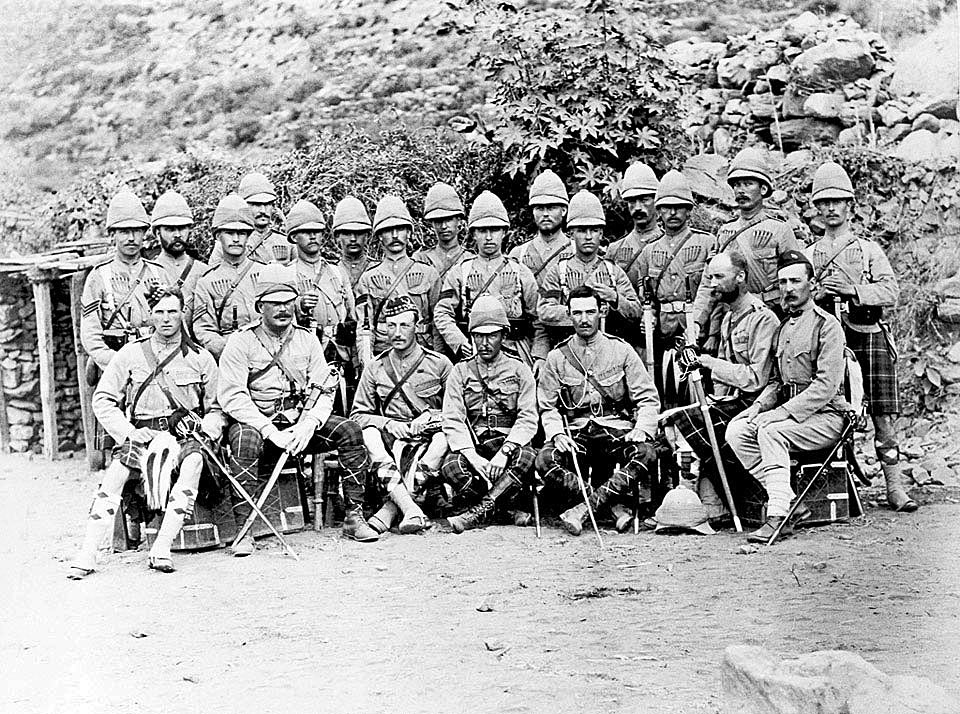
Officers and soldiers of 2nd Seaforth Highlanders: Black Mountain Expedition from 1st October 1888 to 13th November 1888 on the North-West Frontier of India
Winner of the Black Mountain Expedition 1888: The British and Indian troops of the Hazara Field Force.
Background to the Black Mountain Expedition 1888:
The conquest of the Punjab by the British, following the Sikh Wars from 1845 to 1849, extended the frontiers of British India to the western boundary of the old Sikh State, along the Indus River. The Indus rises in the Hindu Kush and runs through Kashmir, fed by several important tributaries, until it flows down the western side of the central Indian landmass, achieving considerable size, in places a mile wide.
The border of British India, at its northern end, followed the Indus into the lower mountain areas and turned north-east away from the river towards Kashmir.
On the northern side of the border, beyond British authority on the east bank of the Indus River, lay the Black Mountain, home to the Hassanzai and Akazai tribes of Pathans. To the east of these Pathan tribes lived the Swati tribes of Pariari Sayids, Allais and, directly along the border, the Tikaris and Nandihars.
A British garrison was maintained at Oghi Fort, some ten miles east of the Upper Indus and some five miles south of the border line.
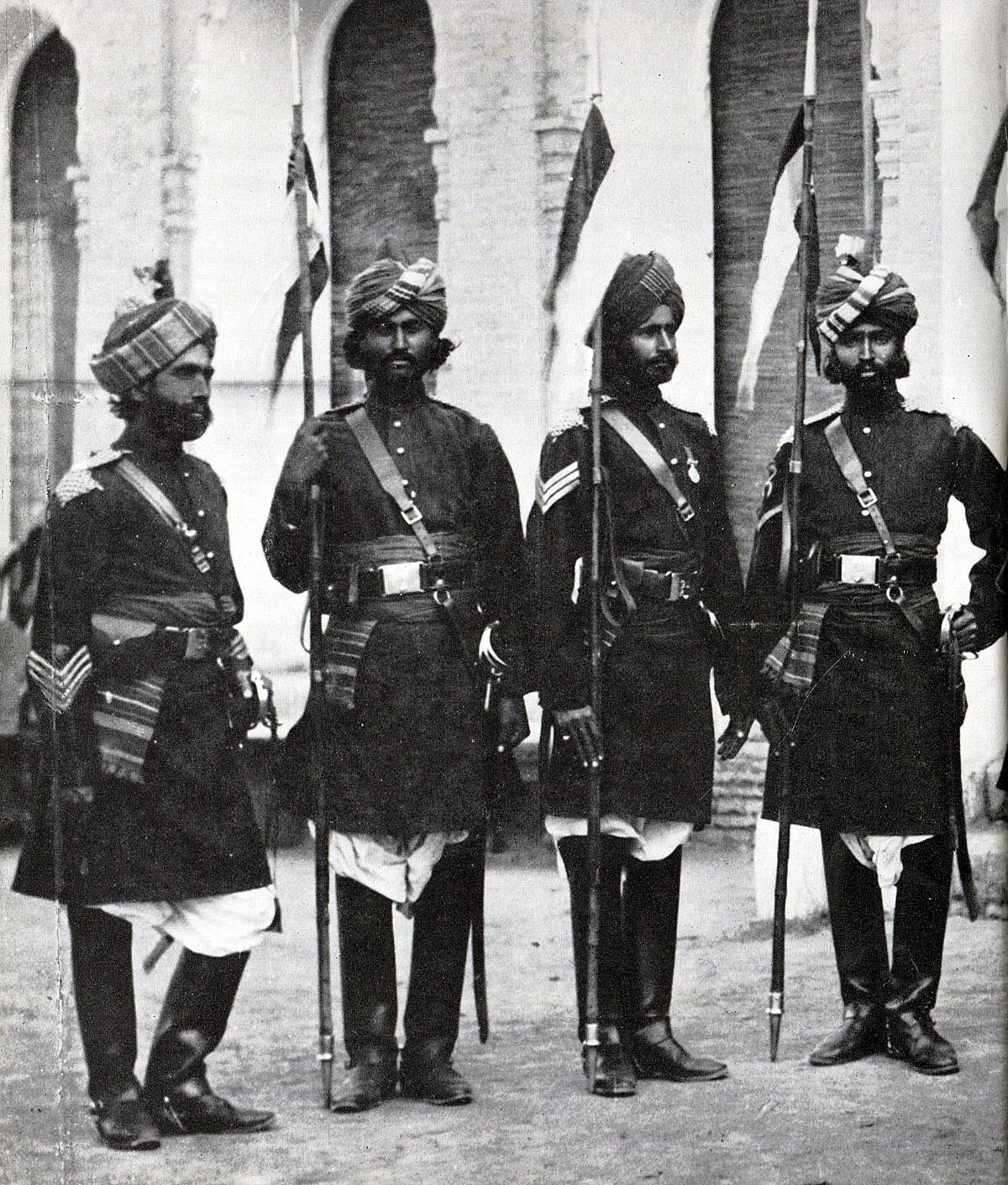
15th Lancers Cureton’s Multanis: Black Mountain Expedition from 1st October 1888 to 13th November 1888 on the North-West Frontier of India
Persistent and troublesome cross border fighting and raiding followed the establishment of the British border. The final incident, which caused the Indian Government to act, took place on 18th June 1888, when a patrol of 60 soldiers from 5th Gurkhas and 19 police, commanded by Major Battye of the 5th Gurkhas and Captain Urmston of the Punjab Infantry, left Oghi Fort and patrolled up to the border at Chitabat. The patrol was fired on by tribesmen from across the border and began a withdrawal to Oghi Fort. Extracting troops from action with tribesmen on the North-West Frontier was always tricky, as it was the tactic of the tribesmen to press a retreating force very closely. During this withdrawal both British officers were killed and their bodies stripped.
The Government of India ordered a punitive expedition against the tribes considered to be responsible for the murders of the two officers; the Hassanzais, Akazais, Pariari Sayids, Tikaris, Nandihars and Allais.
The force mobilised to attack the Black Mountain tribes was denominated ‘The Hazara Field Force’ and put under the command of Brigadier-General McQueen, with the acting rank of Major-General. The force comprised 10,000 troops in thirteen infantry battalions with three batteries of mountain guns and a company of Sappers and Miners (Engineers). The force was formed into four columns and a headquarters. Three columns and the HQ assembled at Oghi Fort in the Agror valley, with the Fourth column assembled at Darband on the Indus River, all by 1st October 1888.
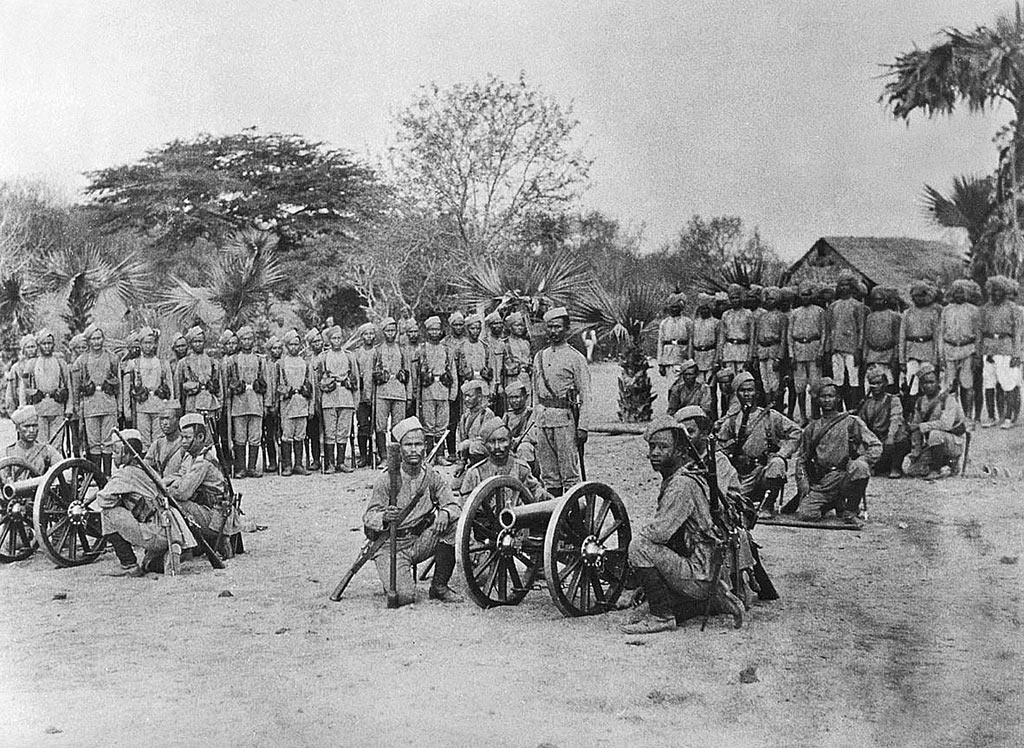
Gurkhas with 7 pounder mountain gun teams: Black Mountain Expedition from 1st October 1888 to 13th November 1888 on the North-West Frontier of India
The Maharajah of Kashmir volunteered his army for the force and two battalions of Kashmiri troops with two guns joined the expedition, as did some 600 members of the Khyber Rifles.
The instructions to the force commander were to coerce the tribes into a suitable form of submission, in consultation with the Chief Political Officer for the area, if the tribes had not submitted by 2nd October 1888.
Regiments in the Black Mountain Expedition 1888:
Royal Artillery
2nd Northumberland Fusiliers
1st Suffolk Regiment
2nd Royal Irish Regiment
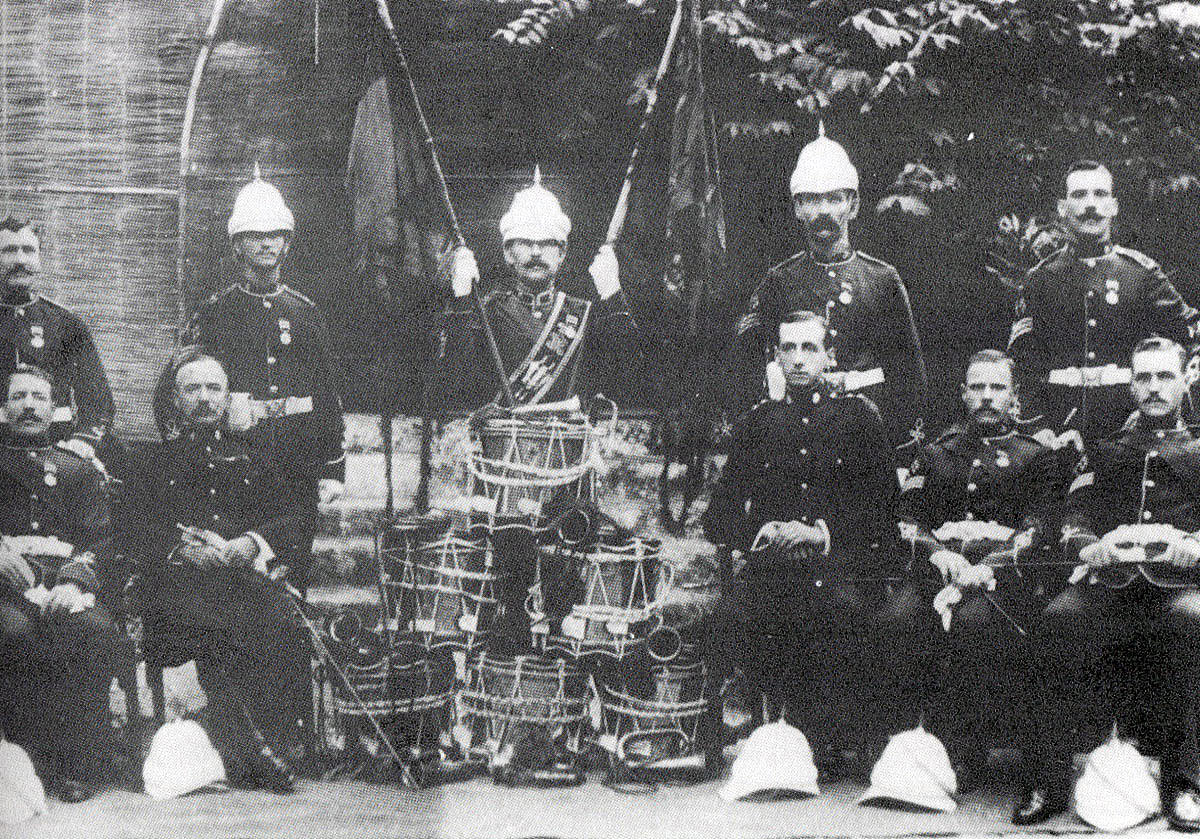
Officers and NCOs of 2nd Royal Irish Regiment: Black Mountain Expedition from 1st October 1888 to 13th November 1888 on the North-West Frontier of India
2nd Royal Sussex Regiment
2nd Seaforth Highlanders
15th Bengal Lancers
34th Pioneers
40th Bengal Infantry
2nd Sikhs
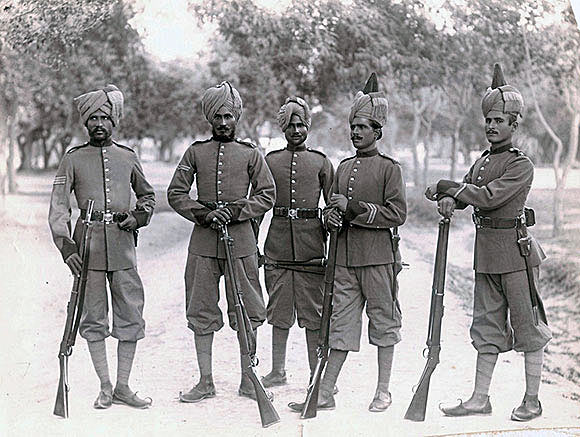
Soldiers of the 2nd Sikhs: Black Mountain Expedition from 1st October 1888 to 13th November 1888 on the North-West Frontier of India
3rd Sikhs
14th Sikhs
4th Punjab Infantry
29th Punjab Infantry
1st/5th Gurkhas
No 4 Hazara Mountain Battery
3rd Company, Sappers and Miners
Kashmir Contingent
Khyber Rifles
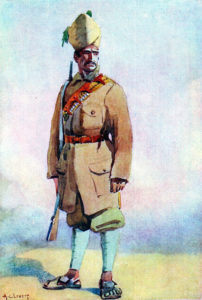
Khyber Rifles: Black Mountain Expedition from 1st October 1888 to 13th November 1888 on the North-West Frontier of India: picture by AC Lovett
The makeup of the columns (First Brigade: First and Second Columns: Second Brigade: Third and Fourth Columns):
First Column: commanded by Colonel J.M. Sym 5th Gurkhas: 2nd Northumberland Fusiliers, 3rd Sikhs, 1st/5th Gurkhas, four guns of No 4 Hazara Mountain Battery, ½ 3rd Company, Sappers and Miners.
Second Column: commanded by Colonel R.H. O’Grady Haly: 1st Suffolk Regiment, a wing (half a battalion) of 34th Pioneers, 40th Bengal Infantry, two guns of Mountain Battery, Royal Artillery and two Gatling guns. This column was accompanied by the brigade commander, Brigadier-General Channer VC and headquarters First Brigade.
Third Column: commanded by Lieutenant-Colonel M.S.J. Sunderland: two guns, Royal Artillery, two guns of No 2 Derajat Mountain Battery, 2nd Royal Sussex Regiment, 14th Sikhs and ½ 3rd Company, Sappers and Miners.
Fourth Column: commanded by Colonel Crookshanks CB: 2nd Royal Irish Regiment, 4th Punjab Infantry, 29th Punjab Infantry, one battery RA; all comprising 2,450 men. This column was accompanied by Brigadier-General Galbraith and headquarters Second Brigade.
The Reserve Column, which was not brigaded, comprised 2nd Seaforth Highlanders, 15th Bengal Lancers, 2nd Sikhs and the Kashmir Contingent.
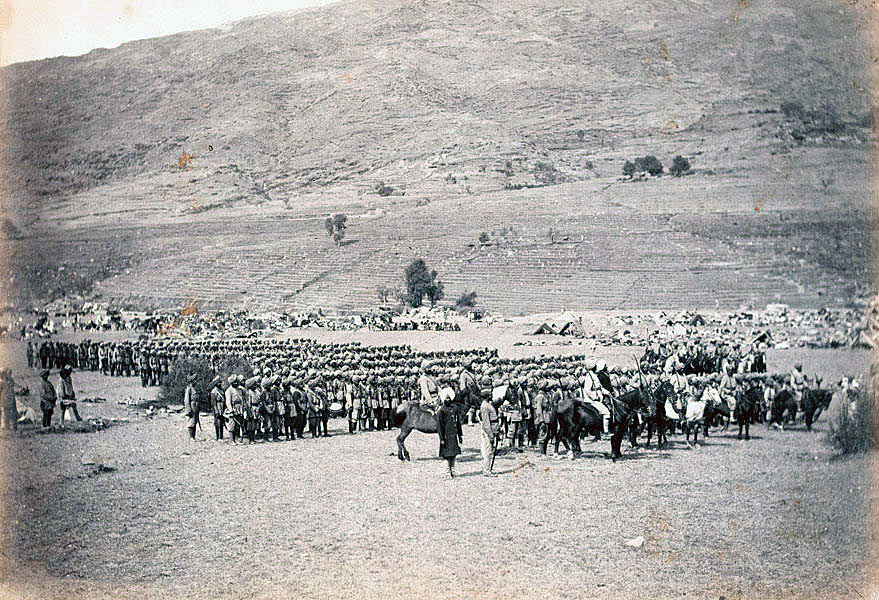
Kashmir Contingent: Black Mountain Expedition from 1st October 1888 to 13th November 1888 on the North-West Frontier of India
The force faced considerable difficulties. The British were familiar with the lay of the land up to the border, but not beyond. There were no reliable maps of the difficult mountainous country beyond the border and the tracks or paths were known to be insufficient for a substantial military force. This was a recurring problem when operations were conducted on the North-West Frontier in areas unknown to the British.
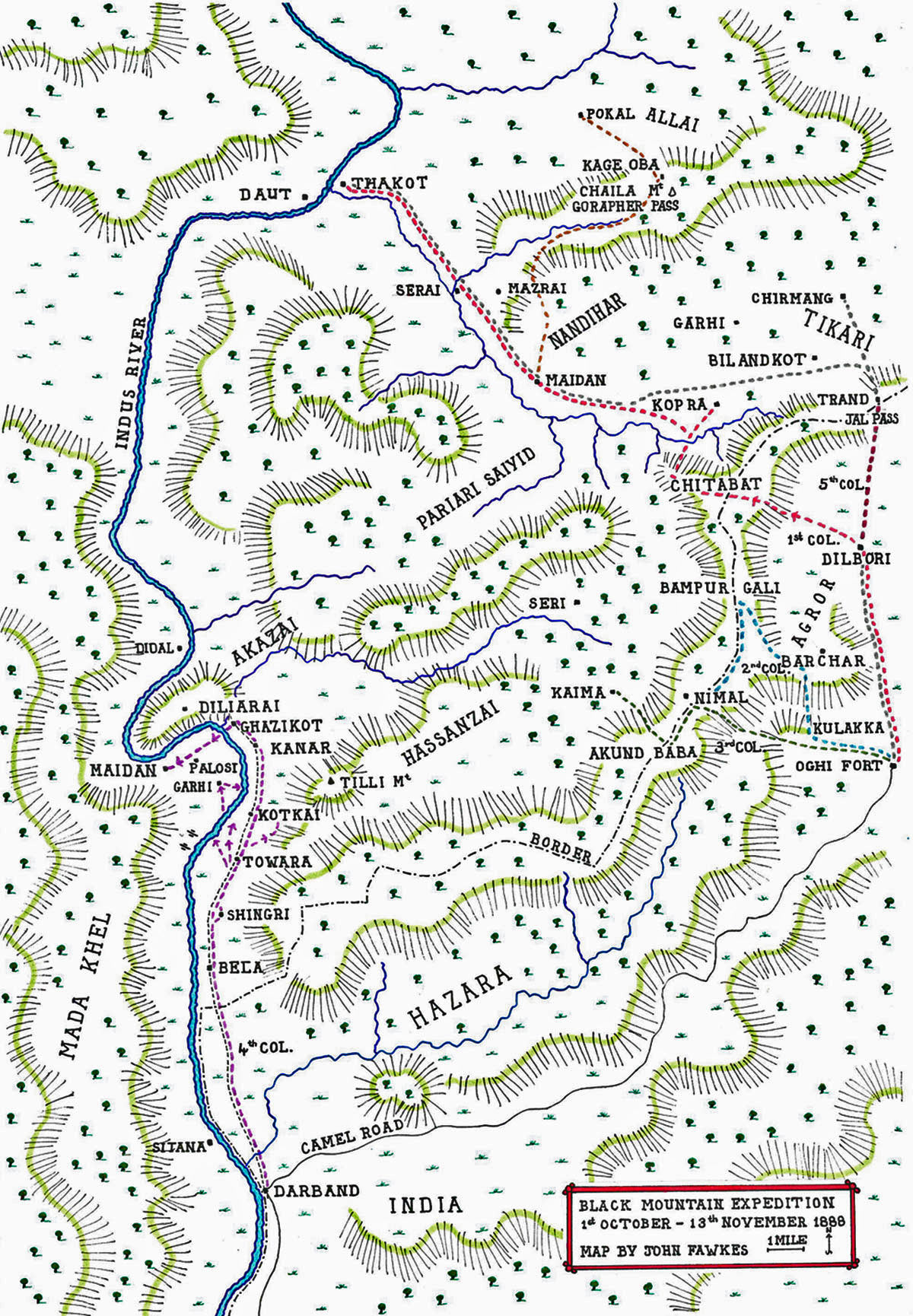
Map of the Black Mountain Expedition from 1st October 1888 to 13th November 1888 on the North-West Frontier of India: map by John Fawkes
Account of the Black Mountain Expedition 1888:
The tribes were given until 2nd October 1888 to submit to British requirements; fines for previous misconduct and the provision of hostages for future good behaviour. None did submit and operations began.
The First, Second and Third Columns were to operate in the mountainous country from the area of Oghi Fort up to and beyond the border of India. The Fourth Column was to march from Darband up the east bank of the Indus River to the village of Kotkai.
The border followed the line of the Indus River from Darband for seven miles to the north and then turned north-east, away from the river, following a high crest for some distance.
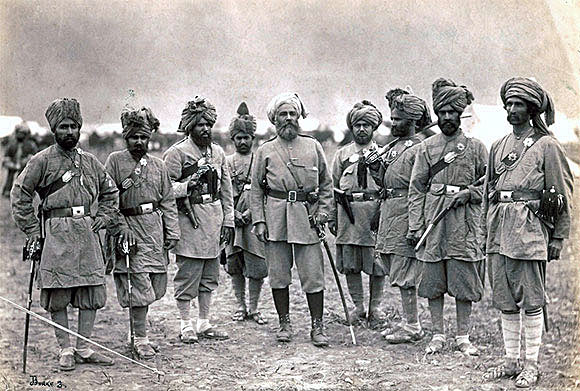
Officers of the Khyber Rifles: Black Mountain Expedition from 1st October 1888 to 13th November 1888 on the North-West Frontier of India
A track followed the east bank of the Indus River to the village of Bela, three-quarters of a mile beyond the point where the border turned north-east and then continued roughly along the river line to Kotkai and beyond. The distance from Darband to Kotkai was about thirteen miles. On 2nd October 1888, this track was improved to carry baggage animals, while the 4th Punjabis cleared a strong force of tribesmen from the ridge above Bela.
The action at Shingri:
On 4th October 1888, the Fourth Column moved up the improved road to Bela, arriving at 8am and on further up the riverbank to the village of Shingri, while the 4th Punjabis held the heights on the right of the column to protect it from attack.
Shingri was on a hill to the right of the track and was occupied by hostile tribesmen. The Royal Irish deployed to the left and the 34th Pioneers occupied a knoll on the right of the village. The column then advanced into Shingri, the tribesmen putting up little resistance and falling back. There was, however, fighting in the hills to the east of the village, where the 34th Pioneers were compelled to storm the Pathan positions. Subadar-Major Chattar Singh Bahadur of the 34th was fatally wounded while leading his company.
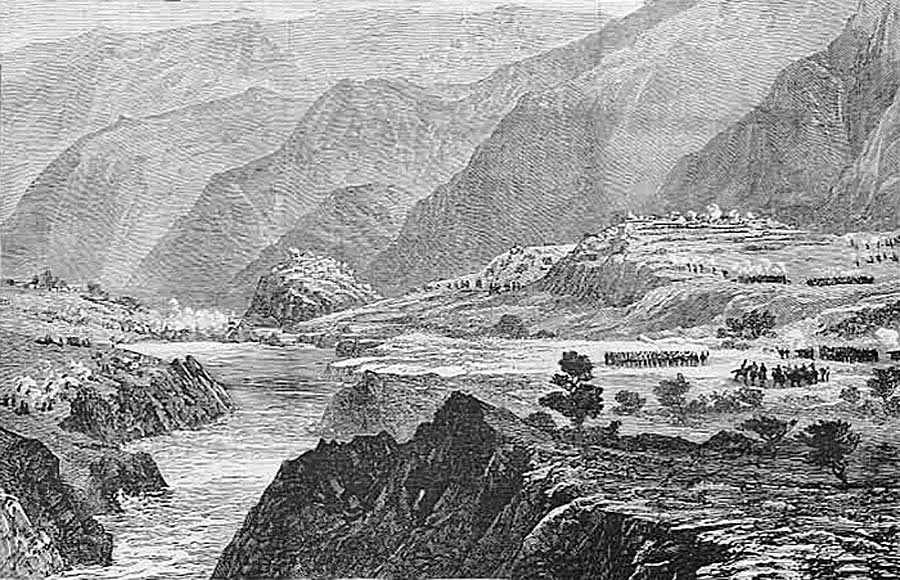
Kotkai occupied by 29th Punjab Infantry: Black Mountain Expedition from 1st October 1888 to 13th November 1888 on the North-West Frontier of India
The actions at Towara and Kotkai:
At 10am on 4th October 1888, the Fourth Column continued its advance in column of route along the track. A mile further on, the tribesmen were found to be in strength in positions around the village of Towara, occupying every point of vantage and protected by numerous stone sangars (improvised stone walls providing cover for musket and rifle fire: a standard North-West Frontier fieldwork). The tribesmen’s positions extended up into the hills, enveloping the column on the track and were also on the other bank of the river. The British and Indian troops could see several aged guns on the far side of the Indus.
The area comprised woods, jungle and stone walled areas of cultivation. Hills mounted up to the heights and mountains to the east. Jungle led down to the Indus river bank to the west of the track. As the column came in range, the tribesmen opened fire from the numerous positions they occupied.
Brigadier-General Galbraith directed the battle. The first step was to clear away the tribesmen threatening the flanks of the column on the track. The Royal Irish were to lead the advance astride the track, in the final approach to Kotkai. The 34th Pioneers moved into the jungle between the track and the Indus River, driving out the tribesmen. The 4th Punjab Infantry were given the difficult task of taking the hills on the right of the column, storming each hill top in turn and clearing the sangars. Captain O.C. Radford of the 4th Punjab Infantry was severely wounded, but continued in action until ordered to seek medical assistance.
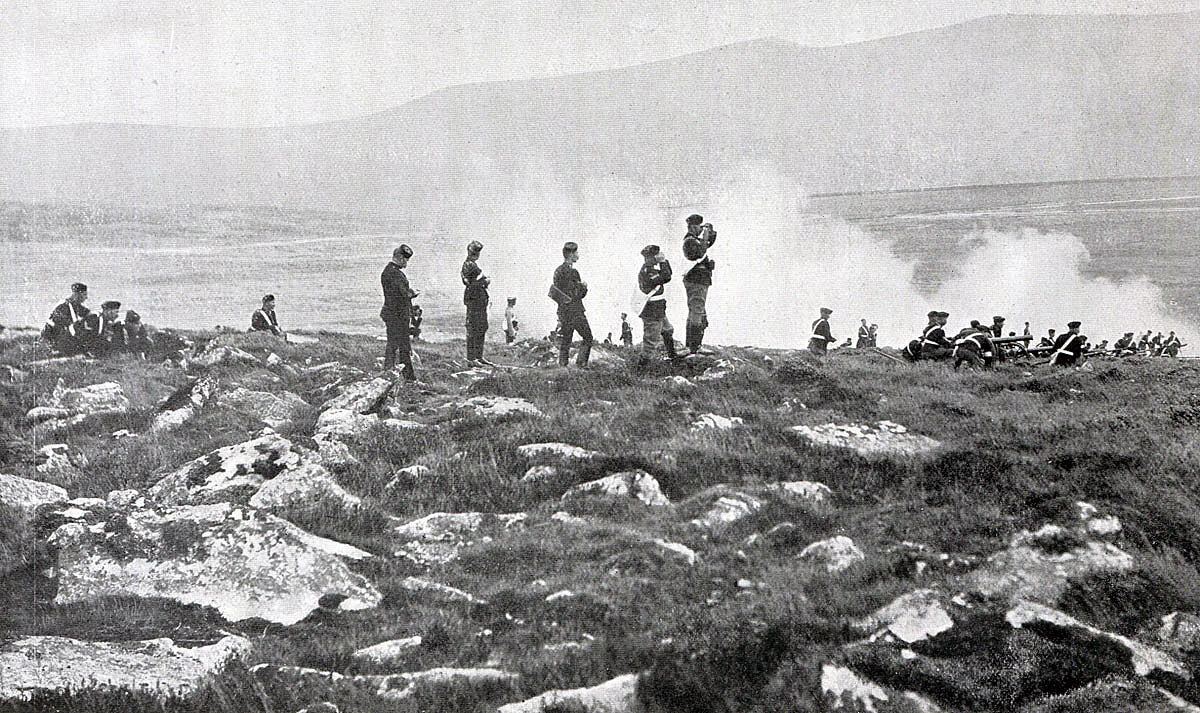
Royal Artillery Mountain Battery in action: Black Mountain Expedition from 1st October 1888 to 13th November 1888 on the North-West Frontier of India
At 1pm, the guns came into action against a wooded hill, which seemed to be the centre of the Pathan positions. After half an hour, the Royal Irish advanced and took the hill, Lieutenant W. Gloster capturing a Pathan standard.
As the Royal Irish advanced, they were subjected to a classic Pathan ploy; a surprise charge from a concealed position of around 100 ‘Ghazis’ or religious fanatics, armed with swords and shields. The Ghazis had been hiding in a nullah or gully on the left front of the Royal Irish. 88 Ghazis were shot by the Royal Irish and the supporting Gatling Guns. A small group of 10 to 15 Ghazis escaped into the jungle heading for the Indus River, but were hunted down by the 29th Punjab Infantry and the 34th Pioneers. Of the 88 Ghazi bodies, 48 were identified as Hindustanis (Indian Muslims who had escaped after the Indian Mutiny and taken refuge in the area).
As the Royal Irish advanced towards the hill, the 34th Sikh Pioneers were directed to move around the side of the hill, on the orders of the Brigadier-General, relayed to them by his DAQMG, Captain Beley DSO. In giving the orders, Captain Beley rode in advance of the 34th into the immediate path of the Ghazi charge. He was overwhelmed and suffered mortal injuries.
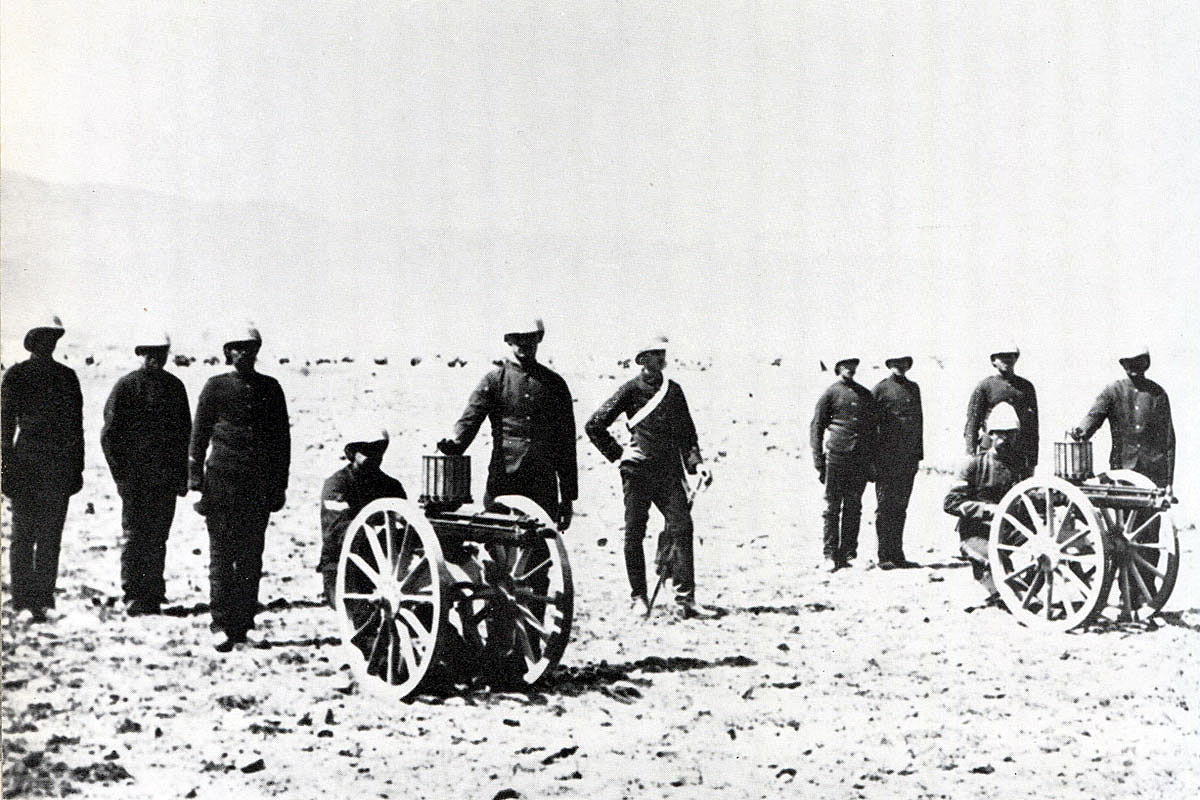
British Army Gatling Guns: Black Mountain Expedition from 1st October 1888 to 13th November 1888 on the North-West Frontier of India
With the hill taken, the guns were able to move forward and lay down a barrage on the positions in front of Kotkai, while the Gatlings fired on the tribesmen resisting the advance of the 4th Punjabis in the hills on the right. These tribesmen began to rush down the hillside into Kotkai and were followed by the fire of the Gatlings. The only fire now coming from the tribesman in any concentration was from the positions on the far side of the Indus River, although this had little effect.
At around 3.30pm, the tribesmen abandoned Kotkai and hurried back towards the village of Kanar further up the river bank. Kotkai was occupied by companies from the Royal Irish and 29th Punjab Infantry, with two guns and the brigade HQ. The Fourth Column had completed the first part of its mission with 5 dead and 10 wounded. The losses of the tribesmen were estimated at around 200.
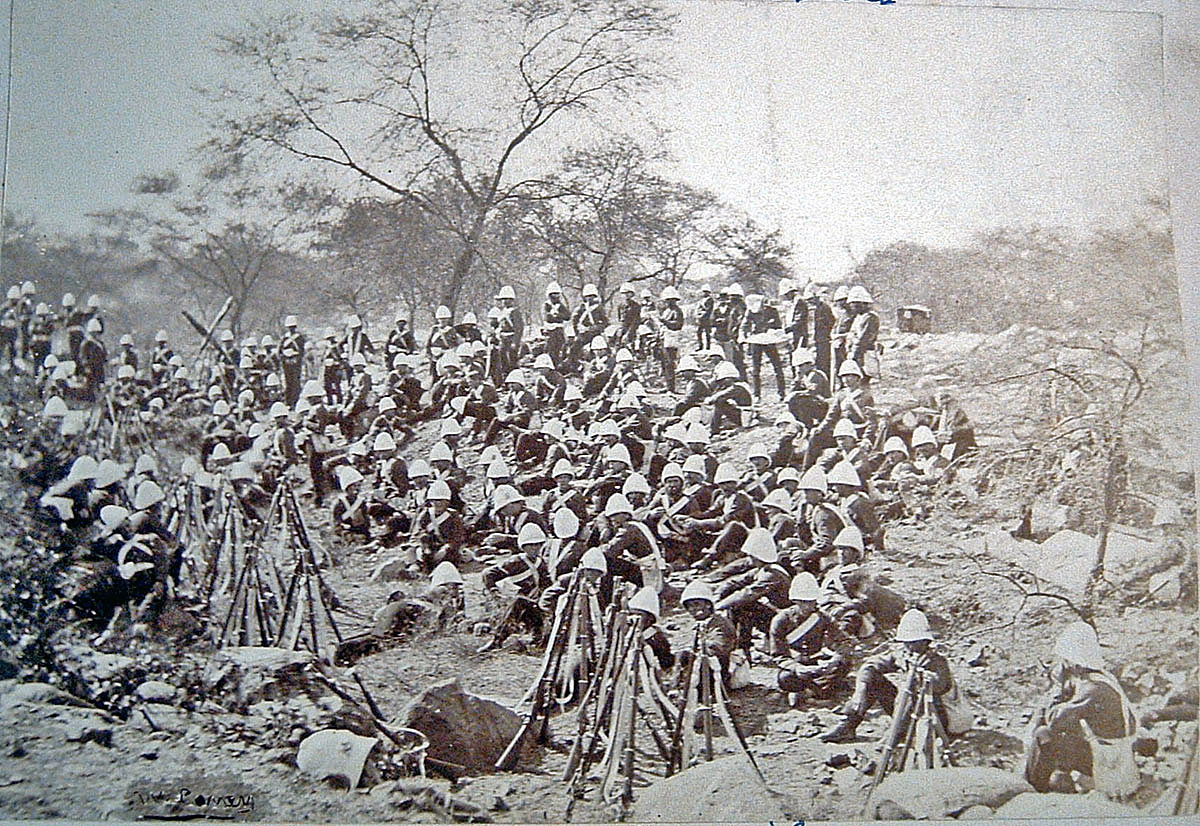
British troops: Black Mountain Expedition from 1st October 1888 to 13th November 1888 on the North-West Frontier of India
Between 5th and 10th October 1888, the Fourth Column stayed in Kotkai while the track from Towara was improved to permit the passage of baggage animals. Reconnaissance parties were sent out into the surrounding country. On 5th October 1888, the column commander, Colonel Crookshanks, advanced up the left bank of the Indus River towards Kanar with the 29th Punjab Infantry. This advance was brought to a halt by the tribesmen’s fire from across the river, which fatally wounded the column commander. Colonel Beddy of the 29th Punjab Infantry now assumed command.
Reconnaissances were conducted to villages on both sides of the Indus. During the withdrawal from the village of Garhi, on the west bank of the river, a determined attack was made on the rear guard of the 4th Punjab Infantry, commanded by Captain Gray, which led to casualties on both sides.
The column advanced to Kanar on 11th and to Ghazikot on 12th October 1888. The Fourth column was now able to communicate by heliograph with the other columns.
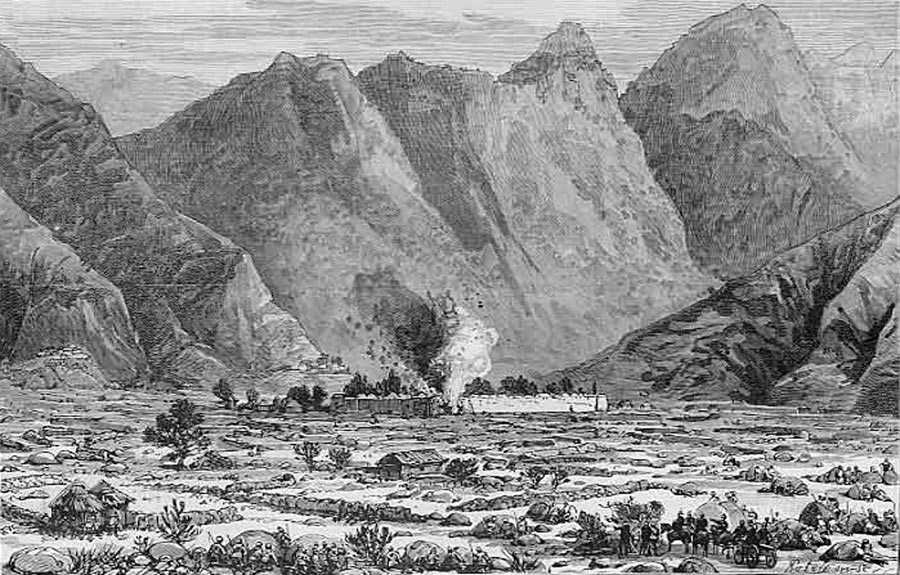
Destruction of Maidan: Black Mountain Expedition from 1st October 1888 to 13th November 1888 on the North-West Frontier of India
The destruction of Maidan:
On 13th October 1888, Brigadier-General Galbraith crossed to the west bank of the Indus with 1,450 riflemen and three guns and burned the Hindustani village of Maidan. The Hindustanis seem to have been cowed by the earlier fighting and no opposition was offered to the incursion. On the same day, Brigadier-General Channer arrived at Kanar from the Second Column with an escort.
Several villages on both sides of the river, including Kotkai, were burnt before the Hassanzai capitulated and sent a jirga (deputation of tribal elders) to Oghi on 2nd November 1888, to negotiate peace.
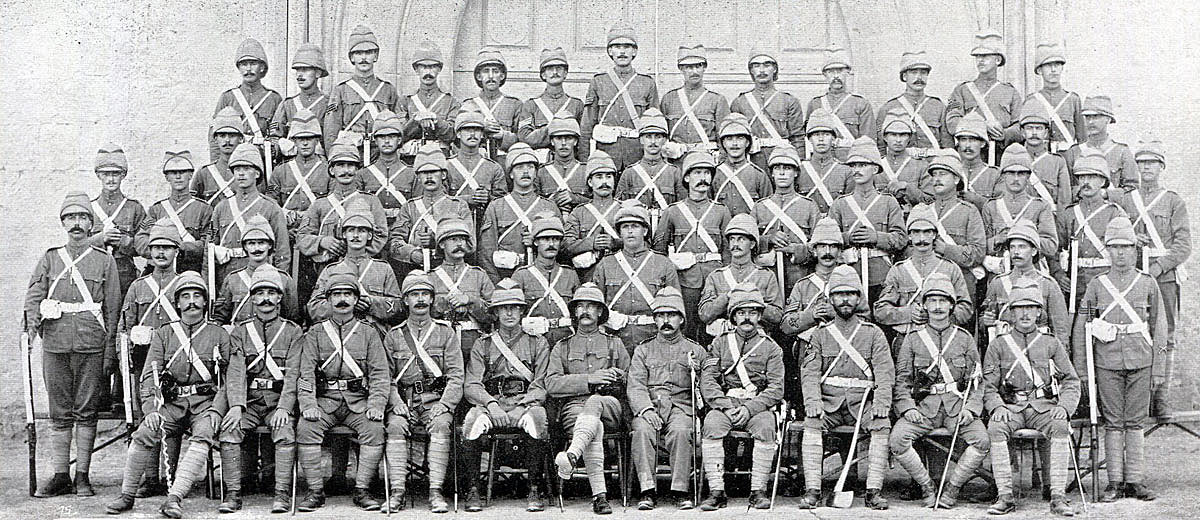
NCOs of 2nd Northumberland Fusiliers: Black Mountain Expedition from 1st October 1888 to 13th November 1888 on the North-West Frontier of India
Actions of the First, Second and Third Columns:
The First Column left Dilbori, the concentration point near Oghi Fort, at 6am on 4th October 1888 and marched to its first bivouac, a distance of around three miles over mountainous country with only the simplest of paths. Tribesmen attacked the bivouac, wounding some camp followers and took 17 mules before being beaten off. The next day, the column moved on to the border and occupied the Chitabat ridge. All along the route, members of the column worked to improve the path to permit the passage baggage animals, under a continuous harassing fire from tribesmen in the surrounding woods and mountains.
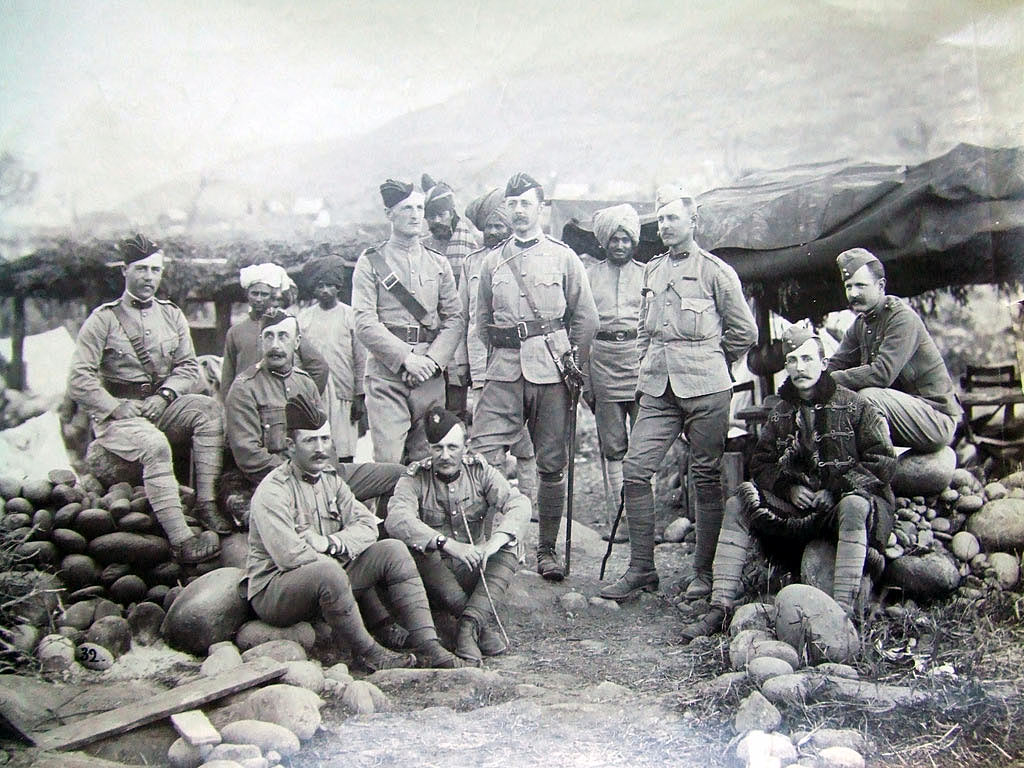
Colonel J.M. Sym, commanding First Column, Hazara Field Force, with his staff: Black Mountain Expedition from 1st October 1888 to 13th November 1888 on the North-West Frontier of India
On 6th October 1888, the First Column found the lack of water and forage for the animals on the Chitabat Ridge to be a difficulty. The baggage mules were escorted back to Dilbori by the 5th Gurkhas and the Hazara Mountain Battery was sent back to Mana-ka-Dana. Five companies of the Northumberland Fusiliers and the 3rd Sikhs advanced across the border to search out a water supply. A spring was found in the valley.
The 3rd Sikh companies were in position on the ridge when they came under attack. The Sikhs advanced vigorously and the Northumberland Fusiliers took the tribesmen in flank, killing several. The troops burned a neighbouring village and took the crops, before returning to the main body on the Chitabat Ridge. The troops suffered no casualties while some 30 tribesmen were killed. The bivouac was not attacked that night. The column remained at Chitabat on 7th October 1888.
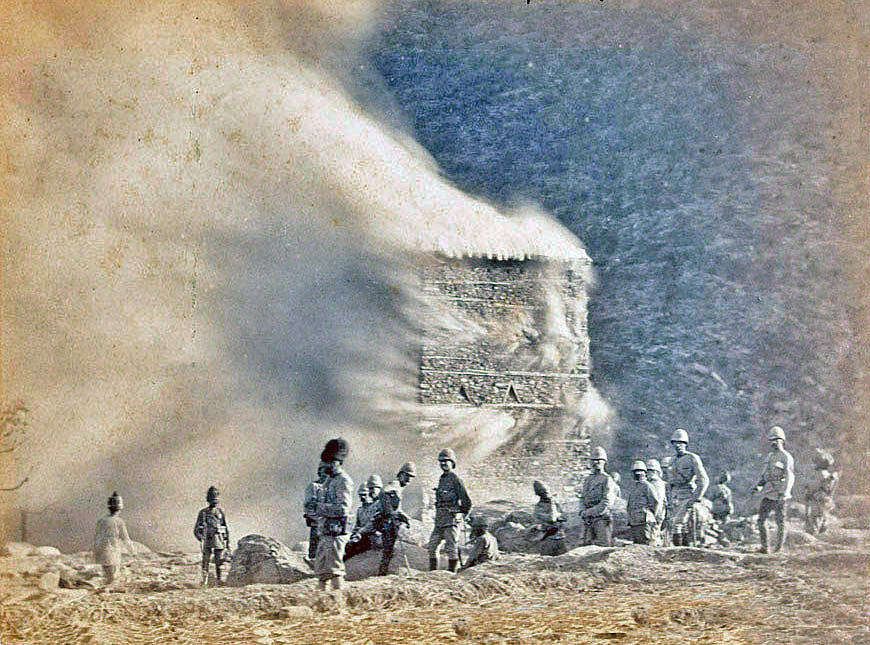
Burning a village: Black Mountain Expedition from 1st October 1888 to 13th November 1888 on the North-West Frontier of India
The Second Column, accompanied by Brigadier-General Channer, commander of the Second Brigade, left Kulakka on 4th October 1888 and marched along the Barchar spur, reaching the border near Bampur Gali on 5th October 1888. Little opposition was encountered.
The Second Column moved south-west along the crest, which the border followed, to Nimal on 6th October 1888, taking over the bivouac occupied by the Third Column. During the march, the Sappers improved the track to permit the passage of the column and its baggage, an arduous and time-consuming process. The column remained in Nimal from 7th October 1888 until the end of the first phase of the campaign on 11th October 1888.
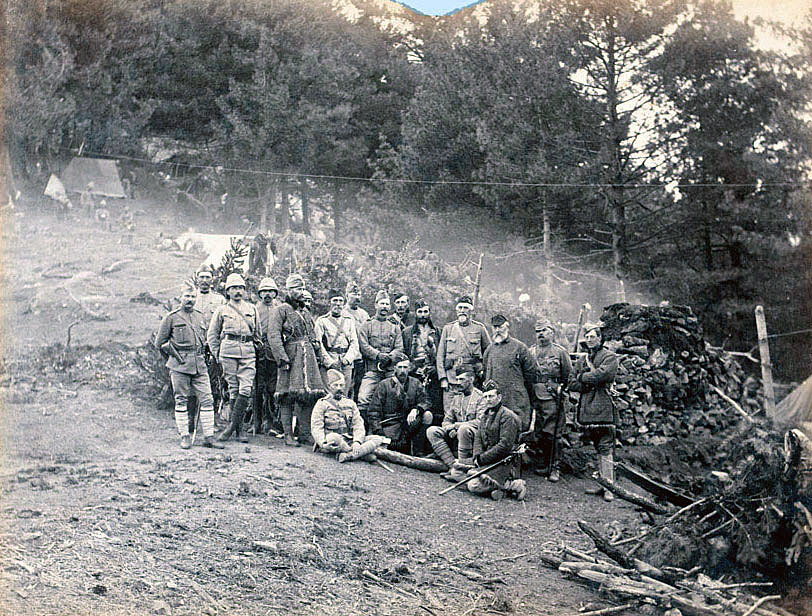
General McQueen and his staff: Black Mountain Expedition from 1st October 1888 to 13th November 1888 on the North-West Frontier of India
The Third Column, accompanied by the Force Commander, Major-General McQueen, and his headquarters staff, moved to the border at Nimal on 4th October 1888.
On 6th October 1888, the Third Column marched west from Nimal, along the top of the ridge, before turning sharp right, crossing the border and moving down into the valley in the direction of Seri. The 14th Sikhs led the advance with the Sappers and Miners making up the road. The path lay through thick woods and the troops were sniped at by tribesmen throughout the march. The column lost 1 dead and 8 wounded. At midday, the Third Column was forced to halt and bivouac at the village of Kaima, as the baggage could get no further until the road had been made up.
The columns carried maps of the country beyond the border, compiled from verbal reports. It was found that these maps were wholly inaccurate. In addition, the terrain was mountainous and wooded and much more difficult than had been expected. Smoke could be seen rising from the distant village of Seri and its surrounding villages. It appeared that the Khan Khels, a sub-tribe of the Hassanzais whose villages they were, had fired the buildings in an attempt to avoid having them destroyed by the invading force.
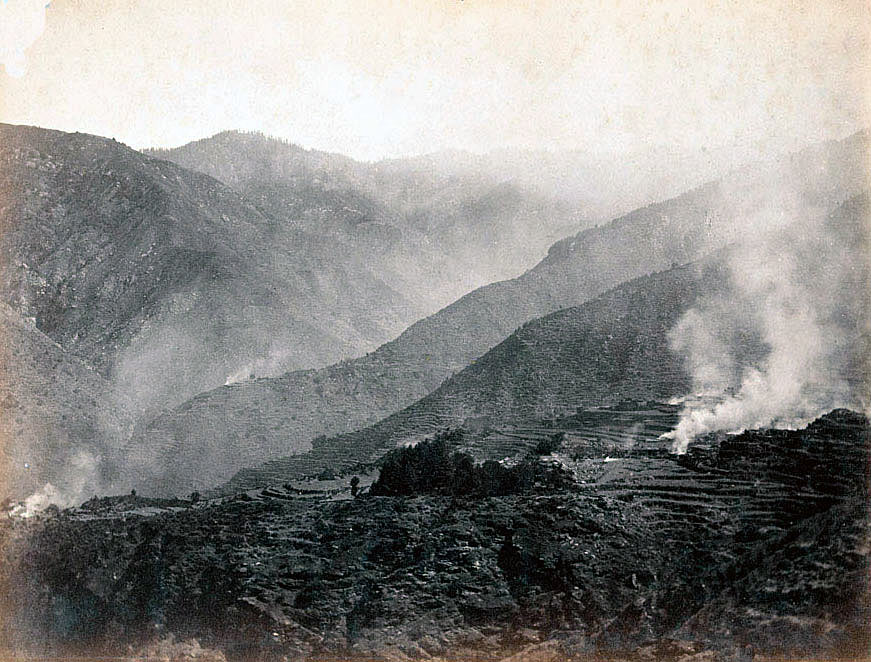
Burning villages: Black Mountain Expedition from 1st October 1888 to 13th November 1888 on the North-West Frontier of India
In view of the lack of water and the difficulty of making progress through the close wooded country, the Third Column returned to the border crest. As was always the way on the North-West Frontier, the withdrawal of the troops attracted close pursuit by the tribesmen and the rear guard was hard pressed, losing 3 men killed and 1 wounded. The Third Column bivouacked near Akund Baba, while the force commander, with his headquarters staff, bivouacked at a site partway between the Second and Third Columns.
From 11th October 1888, the First, Second and Third Columns remained in their positions on the border crest, while the Fourth Column continued operations along the Indus River bank. Numerous parties were sent into Hassanzai and Akazai country, to destroy villages and crops. On 19th October 1888, the tribes under attack accepted the terms offered unconditionally and operations against the Hassanzai and Akazai ceased.
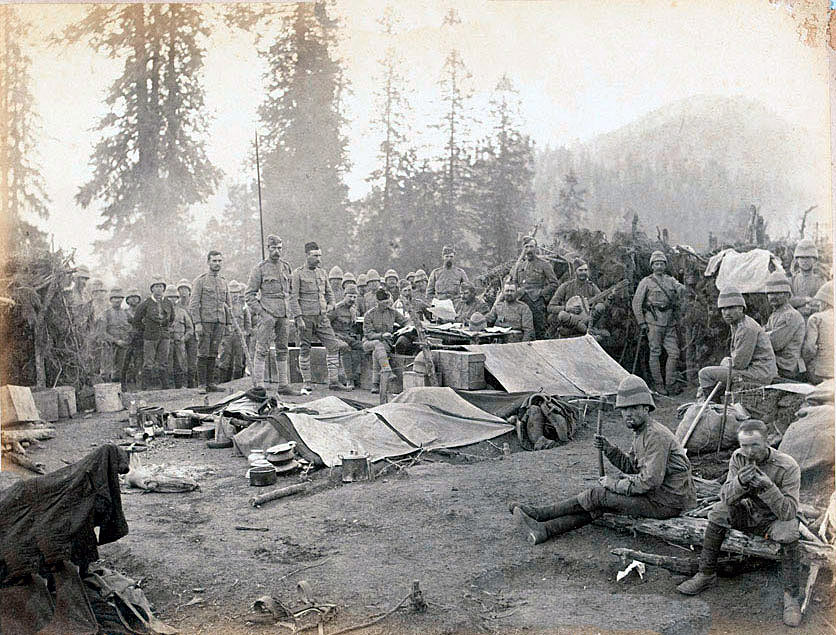
2nd Northumberland Fusiliers in camp: Black Mountain Expedition from 1st October 1888 to 13th November 1888 on the North-West Frontier of India
Operations against the Pariari Sayids and the Tikariwals began on 21st October 1888. These Swati tribes (not Pathans) lived in the mountainous country to the north of the Akazais.
A Fifth Column was formed from the Reserve Brigade, commanded by Colonel A. Murray of the Seaforth Highlanders and comprising a wing of 2nd Seaforth Highlanders (the old 78th), the 40th Bengal Infantry, the force from the Khyber Rifles, two guns from the Royal Artillery and two Gatling Guns. Brigadier-General Channer accompanied the Fifth Column.
The Fifth Column moved to Dilbori and, on 21st October 1888, to Trand on the border. The Fifth Column crossed the border and camped some three miles on the route north towards Thakot, which lies on the Indus and was the immediate target for this phase of the operations against the Pariari Sayids.
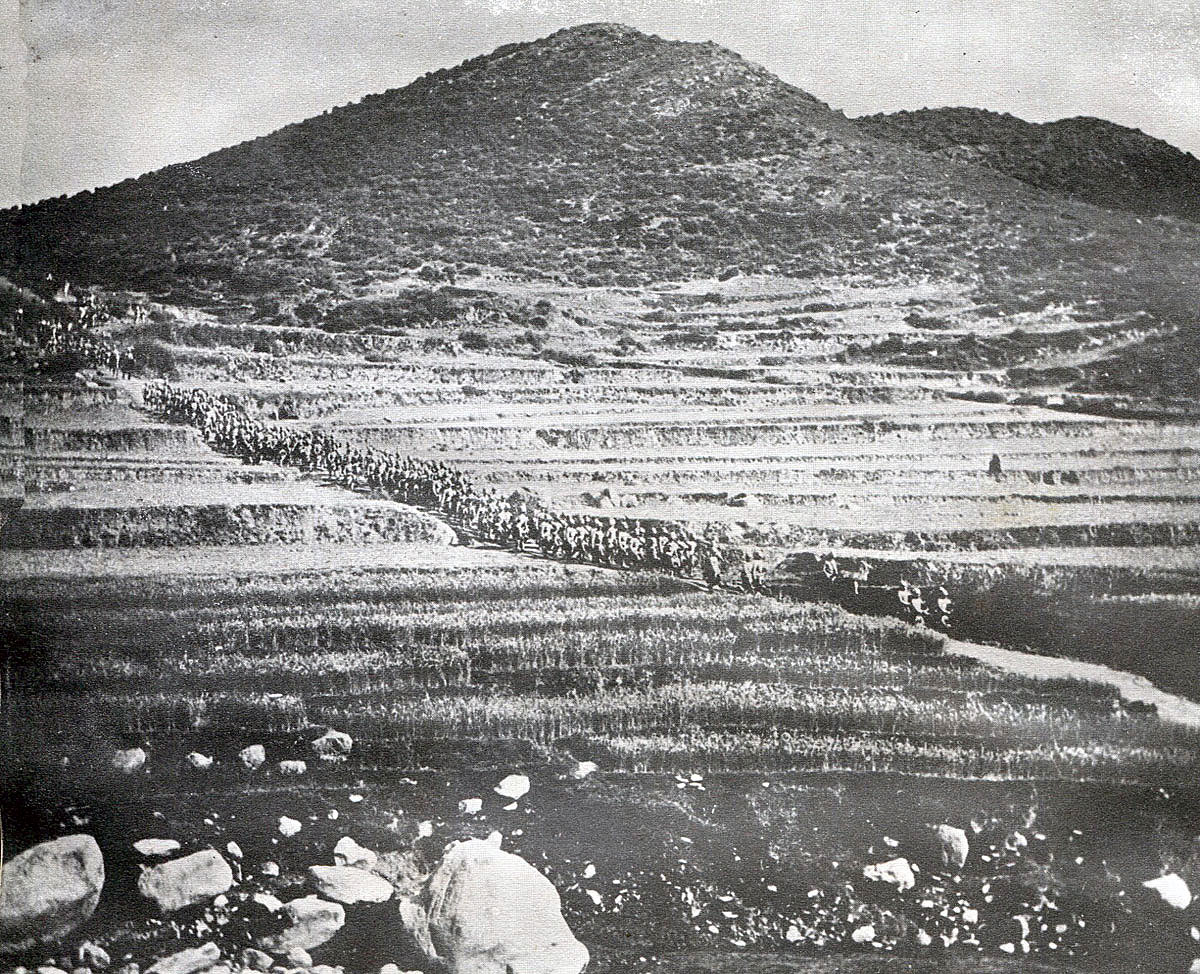
2nd Seaforth Highlanders on the march: Black Mountain Expedition from 1st October 1888 to 13th November 1888 on the North-West Frontier of India
The Fifth Column sent parties forward to the village of Chirmang and found it abandoned. That evening the local headmen capitulated and paid the fine imposed on them.
On 22nd October 1888, Major-General McQueen reconnoitred the area, while planning his operations in the Pariari Sayid country. A Pariari Sayid jirga came into the camp to seek terms, but was considered to be lacking the necessary tribal headmen and was rejected.
On 23rd October 1888, the Maliks of Thakot were invited to send a jirga to the force headquarters to discuss terms.
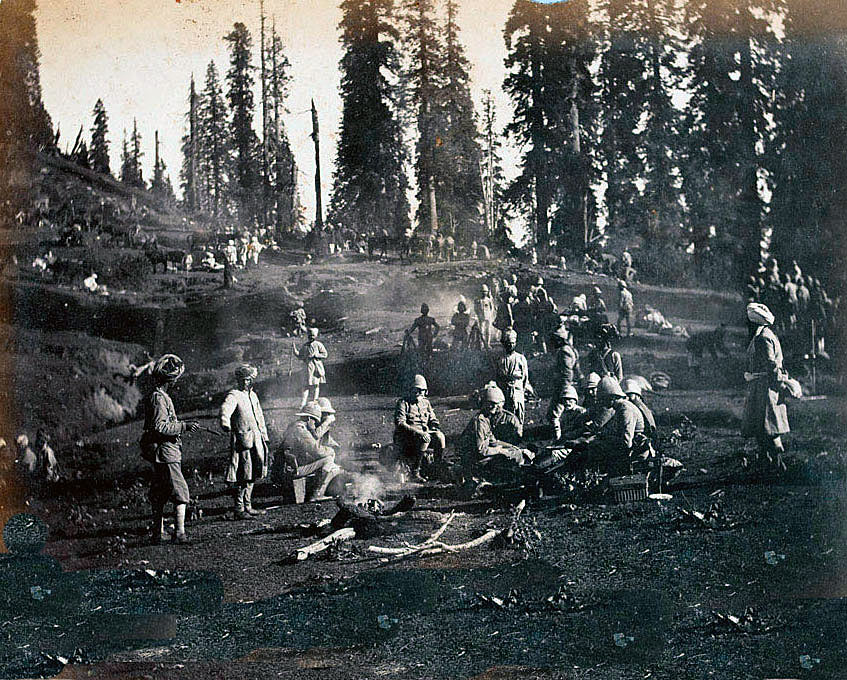
General McQueen and his staff at breakfast: Black Mountain Expedition from 1st October 1888 to 13th November 1888 on the North-West Frontier of India
On 24th October 1888, the Fifth Column moved against the village of Garhi, while a wing of the 3rd Sikhs from the First Column moved against the village of Kopra, covered by two RA guns in position at Bilandkot. Both these villages were destroyed. A force from Chitabat of 200 men and 2 guns covered the western flank of this operation.
Between 25th and 27th October 1888, the First and Fifth Columns advanced on Thakot, Major-General McQueen accompanying the First Column. Part of the road was up an extremely steep mountainside and the Sappers were employed in track improvements throughout the march.
On 27th October 1888, the Chief Political Officer received a letter from the Thakotis asking for twenty days to assemble their jirga. This was seen as a ploy to delay the incursion into their country until the snows arrived and made further progress impossible.
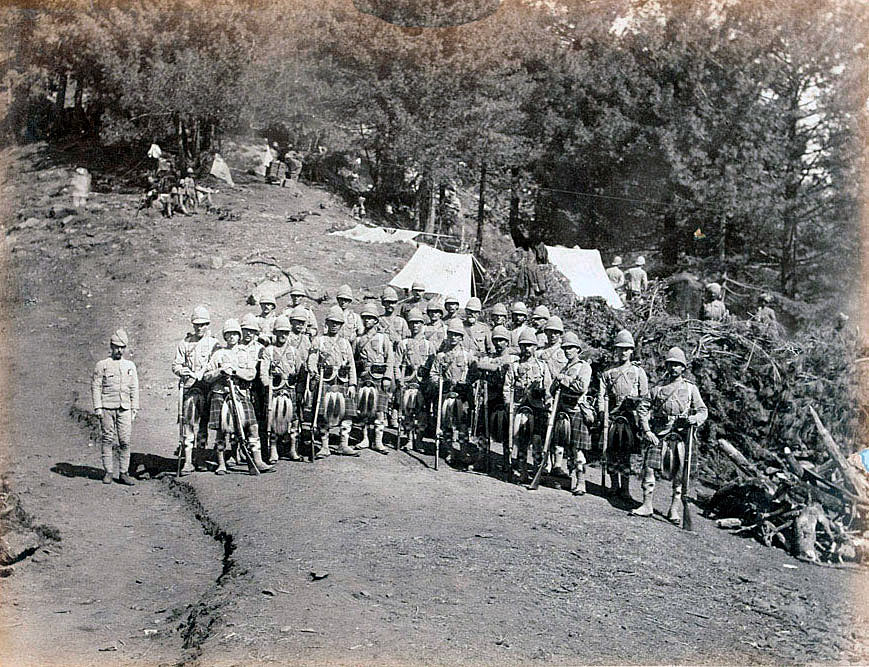
2nd Seaforth Highlanders: Black Mountain Expedition from 1st October 1888 to 13th November 1888 on the North-West Frontier of India
On 28th October 1888, a force left camp for the march to Thakot, with as little baggage as possible. This force was commanded by Brigadier-General Channer and comprised troops from the 2nd Seaforth Highlanders, the 3rd Sikhs, the 34th Pioneers, the Khyber Rifles, two RA guns and two Gatling Guns. The soldiers carried their weapons and ammunition, a blanket and one day’s rations. Much of the route was down a steep mountainside.
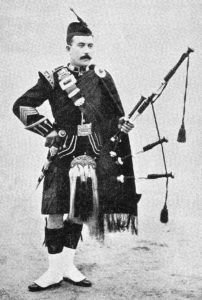
Seaforth Highlanders Pipe Major: Black Mountain Expedition from 1st October 1888 to 13th November 1888 on the North-West Frontier of India
The action at Thakot:
On reaching Thakot, the brigadier marched his force through the village, the pipers of the Seaforth Highlanders playing the pipe tune ‘Oh but ye’ve been a lang time acoming’. It was understood that the inhabitants of the area considered themselves invulnerable, because the British force had not penetrated this part of the country during the operations in 1868.
During the afternoon of 27th October 1888, the force came under fire from the village of Daut, across the Indus River and from the heights above Thakot. The Gatlings were used to suppress the fire from the heights, which were then scaled by the Khyber Rifles and the 34th Pioneers. The next day, before leaving the area of Thakot, the guns shelled the village of Daut which was set on fire. Thakot was not damaged as the inhabitants had not resisted. The force then withdrew to Serai and on 30th October 1888 to Maidan.
The final hostile area was that of the Allai tribe further to the north-east. The malik, Arsala Khan, failed to comply with the period for submission, which expired on 30th October 1888.
On 31st October 1888, detachments from the First and Fifth Columns, commanded by Brigadier Channer, moved towards the Gorapher Pass (First Column; the 2nd Northumberland Fusiliers, the 34th Pioneers and the 5th Gurkhas, with 50 marksmen from the 1st Suffolks, the 2nd Royal Sussex and the 24th Punjab Infantry, the Hazara Mountain Battery and a half Company of Sappers: Second Column; wing of the 2nd Seaforths, the 3rd Sikh Infantry, the Khyber Rifles and four RA guns). The force bivouacked at Mazrai.
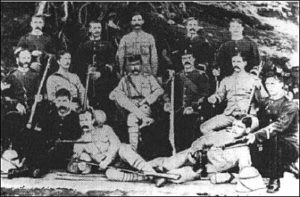
Sharpshooters from 2nd Northumberland Fusiliers: Black Mountain Expedition from 1st October 1888 to 13th November 1888 on the North-West Frontier of India
The action on Chaila Mountain:
On 1st November 1888, the First Column Detachment led the march, supported by the Fifth Column Detachment. The route was along a rising spur for three and a half miles, at the end of which was a precipitous climb to the top of Chaila Mountain. The tribesmen were present on the summit and in the woods at the base of the mountain. The Northumberland Fusiliers and the Khyber Rifles began the climb under fire, which was at times heavy. The guns put down a supporting barrage. The tribesmen beat drums, played pipes and screamed abuse. The crest was taken at around noon and the tribesmen were found to have melted away. Brigadier-General Channer marched on some two and a half miles to the village of Kage Oba, with the First Column Detachment. The detachment spent the night at this village at 9,000 feet, in a hard frost without food or blankets. The baggage and the guns were at the bottom of the Chaila climb, with the Seaforths and 3rd Sikhs holding the crest. The route to the bottom of the climb was so difficult as to be impassable for the mules without considerable work by the Sappers.
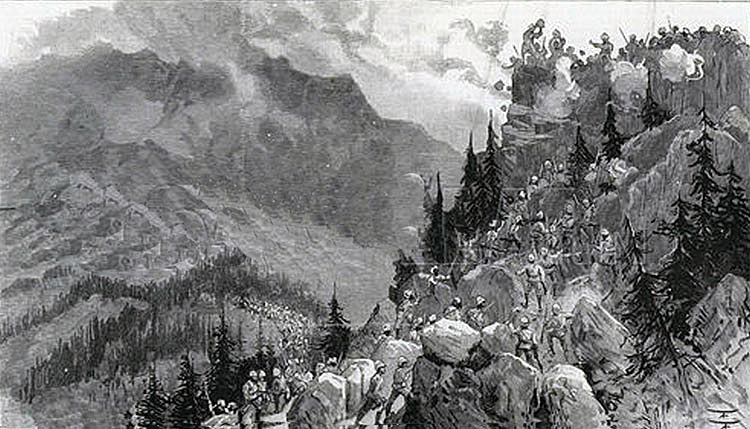
2nd Northumberland Fusiliers and Khyber Rifles storming the Chaila Crag: Black Mountain Expedition from 1st October 1888 to 13th November 1888 on the North-West Frontier of India
A letter was received on the 2nd November 1888 from Arsala Khan, asking the British to wait for a while. During this day, the baggage was moved up the Chaila climb. This took all day and fourteen mules were lost in falls down the precipitous mountainside.
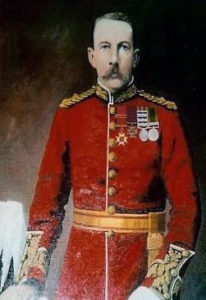
Brigadier General George Channer VC: Black Mountain Expedition from 1st October 1888 to 13th November 1888 on the North-West Frontier of India
Brigadier-General Channer spent the day reconnoitring in the direction of Pokal, Arsal Khan’s chief village. A report was received that Arsal Khan had crossed the Indus River, leaving his son Ghazi Khan in command. Snow began falling during the day, impressing the need to complete the operation before the mountains became impassable for the troops.
The action at Pokal:
On 3rd November 1888, a force comprising companies from the Northumberland Fusiliers, the Seaforth Highlanders, the 5th Gurkhas and the Khyber Rifles and the marksmen from the Suffolk and Sussex Regiments and the 24th Punjab Infantry with two guns, moved forward to destroy Pokal. The path was a gentle downward gradient to a point two miles from Pokal, where the descent became steep and open. The tribesmen offered some resistance, but fell back through the village. The marksmen from the Suffolk and Sussex regiments inflicted significant casualties, with volley fire on the retreating tribesmen.
The village of Pokal, other than the mosque, was burnt and the force began to retire, the Seaforth Highlanders and the Khyber Rifles providing the rear guard. As in every campaign on the North-West Frontier, this was the point at which the tribesmen saw their opportunity for revenge and some 300 tribesmen followed the troops closely to within a mile of the camp, being held back by the volleys of the rear guard. One company of Northumberland Fusiliers occupied a knoll and, waiting for the tribesmen to collect in a group, directed a volley at them. This effectively ended the pursuit.
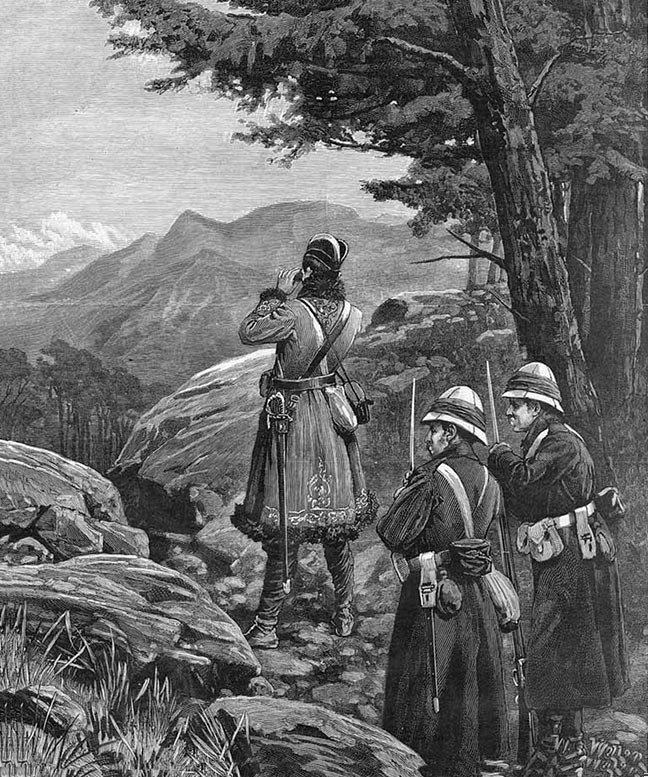
Officer and soldiers of 2nd Northumberland Fusiliers: Black Mountain Expedition from 1st October 1888 to 13th November 1888 on the North-West Frontier of India
In the evening of 3rd November 1888, an Allai jirga came into the camp. Arsala Khan was not represented, but the Chief Political Officer was satisfied that this constituted sufficient compliance and the next day the force withdrew from Allai country to Mazrai. In reality, it was now too late in the year to take more effective action against the Allai.
On 5th November 1888, the force fell back to Maidan. The Allai jirga was dismissed as insufficient, as Arsala Khan was not represented.
While the First and Fifth Columns operated against the Allai, the Second Column moved to Chirmang, to bring pressure to bear on the Pariari Sayids by consuming their crops. As a consequence, the Pariari Sayid jirga came into the camp at Maidan and made the necessary reparations: a fine of 1,500 rupees to be paid by 7th November and the surrender of five headmen as hostages.
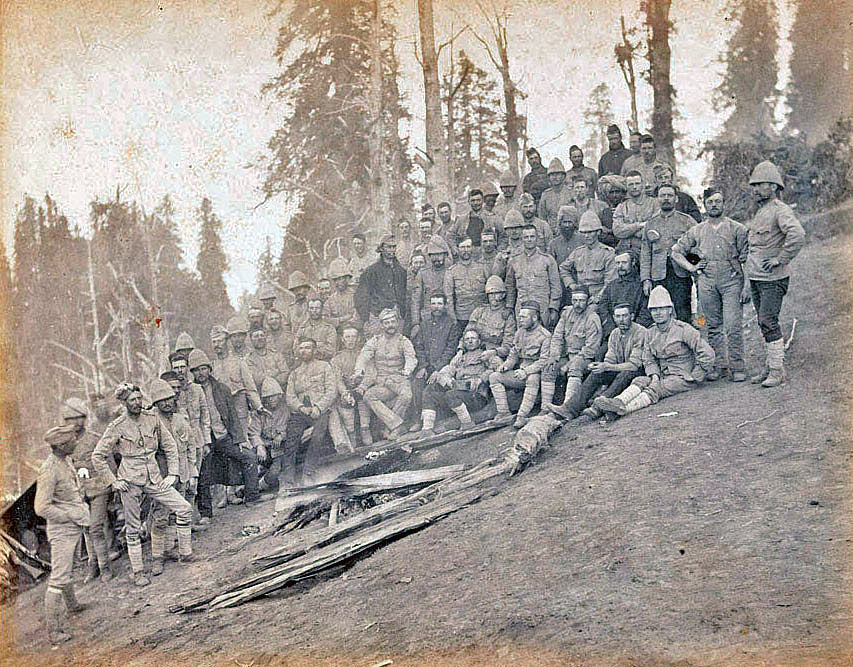
British Officers: Black Mountain Expedition from 1st October 1888 to 13th November 1888 on the North-West Frontier of India
On 10th November 1888, the whole force, other than the Fourth Column, which was on the banks of the Indus River, withdrew to the Agror Valley in British territory.
On 13th November 1888, the Fourth Column withdrew to Darband. The whole force was then dispersed to its home cantonments in India. The campaign was complete.
Casualties from the Black Mountain Expedition 1888: 2 British officers were killed in the campaign: Colonel Crookshanks, the commander of the Fourth Column and his DAQMG Captain Beley. 23 soldiers were killed and 54 wounded. The casualties among the tribes were estimated at around 400 killed and wounded. Remarkably, only a handful of soldiers were lost through disease.
Follow-up to the Black Mountain Expedition 1888: Fines were imposed and paid by the Pariari Sayids. The Hassanzais and Akazais paid fines and provided hostages for their future good behaviour and undertook not to molest troops moving on the British side of the border. All the tribes that submitted agreed not to interfere with roads that had been made in their territories. Nothing further could be done with Arsala Khan of the Allai as he had fled across the Indus. However, his village of Pokal had been destroyed.
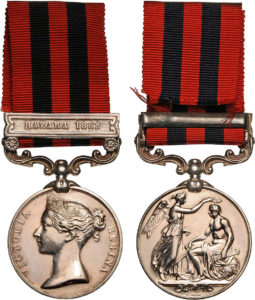
Indian General Service Medal with clasp ‘Hazara 1888’: Black Mountain Expedition from 1st October 1888 to 13th November 1888 on the North-West Frontier of India
Major-General McQueen noted in his report these further important achievements: The Thakot and Allai countries had been opened up by the building of good mule roads. A good camel road had been built along the bank of the Indus River from Darband to Kanar and a detailed survey had been made of 177 square miles of unknown country on the far side of the border. All these measures were of significance, in case a further incursion into this country by British forces was necessary. The next incursion was 3 years later in 1891.
As a final measure, the Khan of Agror was removed from his post for his intrigues against the government of which he was a nominal servant, Agror being within the British Indian border.
Battle Honours and Campaign Medals for the Black Mountain Expedition 1888: The Indian General Service Medal was issued to all ranks taking part in the campaign, with the clasp ‘Hazara 1888’. The campaign is not a battle honour.
Anecdotes and traditions from the Black Mountain Expedition 1888:
- It was noted that a large number of ‘British subjects’ from Hazara and even from Rawalpindi and Jhelum fought with the tribes against the British and Indian troops.
- The 4th Punjab Infantry was one of the original Punjab Frontier Force regiments (known as the ‘Piffers’) and adopted the title of ‘Wilde’s Rifles’ in 1903 on becoming the 57th. The regiment is now the 9th Battalion of the Frontier Force Regiment in the Pakistan Army. Captain O.C. Radford went on to command the Regiment in China in 1901 during the Boxer rebellion. Major-General McQueen became the regimental colonel of the regiment.
- The Khyber Rifles were considered to have performed so well that they were permitted to retain the Snyder rifles that had been issued to them for the campaign. The GOC reported that he had received no complaints about their conduct and many plaudits.
- Lieutenant Gloster served in the South African War and was killed in France during the First World War.
- The 2nd Sikhs, Punjab Frontier Force: The following British officers served with the regiment in the campaign; Colonel HM Pratt, Colonel FE Hastings, Major HFV Gaitskell, Captain CGM Fasken (Brigade Major), Lieutenants T Jermyn, AH Eustace, HC Vesey and PBB Forster. Colonel Pratt was made a Commander of the Bath following the campaign and he, Colonel Hastings and Captain Fasken were mentioned in dispatches. The 2nd Sikhs enlisted Dogras, Punjabi Mussulmans, Sikhs and Pathans. Fasken and Eustace subsequently became major-generals commanding divisions in the Great War/World War 1.
References for the Black Mountain Expedition 1888:
The authority for campaigns on the North-West Frontier of India and other campaigns involving the Indian Army in the 19th Century is the Indian Government publication ‘Frontier and Overseas Expeditions from India’. Six volumes were published around 1905 and distributed internally, primarily to Indian Army Officers and Officials. Volume 1 covers the Black Mountain Expedition of 1888, being the volume on operations north of the Kabul River.
North-West Frontier by Captain H.L. Nevill DSO, RFA
The previous battle in the British Battles sequence is the Siege of Ladysmith
The next battle in the North-West Frontier of India sequence is the Black Mountain Expedition 1891
To the North-West Frontier of India index
